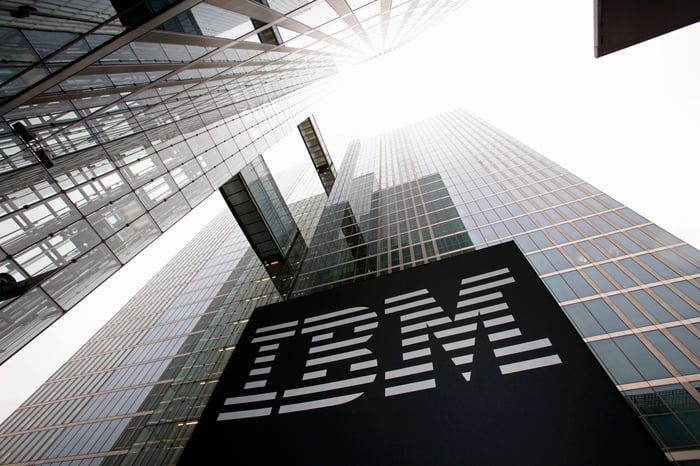The new z14 mainframe from International Business Machines (IBM -0.89%) very nearly ended the company's long streak of revenue declines. Sales slumped by just 0.4% year over year during the third quarter. That marks 22 consecutive quarters of declining revenue, but also IBM's biggest revenue beat in years.
The big news, though, is that IBM expects to produce revenue growth during the fourth quarter. CFO Martin Schroeter said during the conference call that he expects the mainframe cycle to drive a stronger fourth quarter this year. Based on the numbers he laid out, revenue could grow by as much as 1.3% year over year. That may not sound impressive, but it will be the first time in a long time that IBM has managed to move the top line in the right direction.

Image source: IBM.
Growth where it counts
There were no real surprises in IBM's third-quarter results, other than total revenue coming in well ahead of analyst estimates. The company produced $19.15 billion of sales, about $550 million more than analysts were expecting. A big boost in mainframe sales and strong cloud growth came close to offsetting continued declines in IBM's legacy businesses.
The z14 mainframe began shipping in mid-September, so the initial sales boost that IBM sees when it launches a new mainframe system will leak into the fourth quarter. Mainframe sales soared 62% year over year during the third quarter, helping to drive a 14% rise in systems hardware revenue.
The cloud computing business also grew at an impressive pace. Trailing-12-month cloud revenue jumped 25% year over year to $15.8 billion, accounting for 20% of IBM's total revenue. Cloud delivered as a service reached a $9.4 billion annual revenue run rate, also up 25% year over year. IBM's cloud business includes not only public infrastructure as a service but also hybrid cloud, private cloud, and high-value services like those built on Watson.
IBM's strategic-imperative businesses, comprised of analytics, cloud, mobile, security, and social, produced 11% year-over-year growth during the third quarter. Over the past 12 months, the strategic imperatives generated $34.9 billion of revenue, roughly 45% of IBM's total revenue. The rest of IBM's business, what it calls its "core" business, slumped by 8% during the quarter. The inflection point where declines in the core business are finally overcome by growth in the strategic imperatives is tantalizingly close.
IBM produced $3.30 in adjusted earnings per share during the third quarter, up $0.01 from the prior-year period and $0.02 higher than the average analyst estimate. The company reiterated its full-year earnings guidance, calling for adjusted EPS of at least $13.80, along with roughly flat free cash flow.
A strong fourth quarter expected
IBM generally doesn't provide much in the way of revenue guidance, but the company made an exception during the conference call. Schroeter explained that the mainframe cycle would drive a stronger fourth quarter than last year, estimating that the change in revenue from the third quarter would be between $2.8 billion and $2.9 billion. That range implies year-over-year revenue growth, no doubt music to IBM shareholders' ears.
If IBM delivers on that target, its streak of revenue declines will end at 22 quarters. Ironically, despite its transformation being based on hot technologies like cloud computing and artificial intelligence, it will be the decades-old mainframe business that ultimately pushes IBM's top line back into positive territory.
Whether or not this expected bump in revenue is sustainable is unclear. The mainframe cycle typically produces an initial sales spike that peters out over the span of a few quarters. As IBM enters 2018, the strategic imperatives will need to become the driver of revenue growth as mainframe sales moderate.
IBM needed to change the narrative with its third-quarter report, and it appears to have done just that. A return to revenue growth is on the horizon, and if the initial boost to the stock following the third-quarter report is any indication, investors are pretty happy about that. A return to growth doesn't mark the end of IBM's transformation, but it's an important milestone that provides some evidence that the company's strategy is working.





